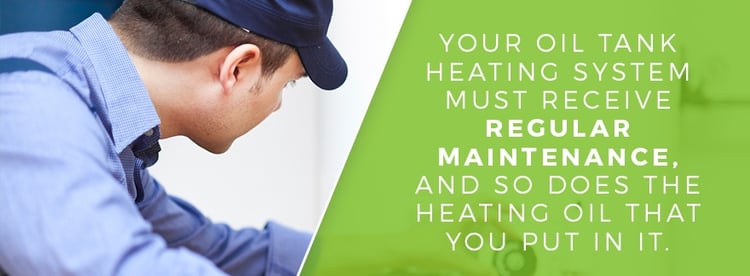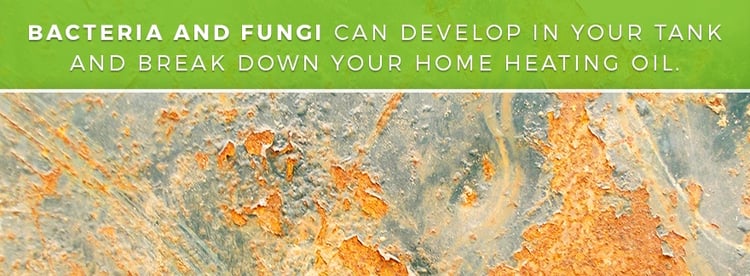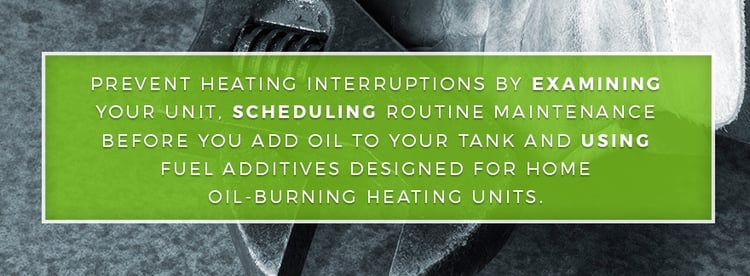
If you’re like most people living in cold-weather climates, once the temperature starts to drop, you don’t care how your home heating system works. You just care that it works and works well. Come late November, the last thing you want is for your oil-tank heating system to break down or suffer from reduced efficiency, just as temperatures are starting to drop and heating oil prices are adjusting to their seasonal highs. That’s why it’s essential to maintain both the system and the heating oil it burns. Using a home heating oil treatment as a preventative measure can help ensure that your heating system produces ample heat and maintains its efficiency throughout the winter.
The Cost of Preventative Maintenance

Owning and maintaining a home is expensive, so homeowners are often dubious when it comes to spending money for “increased efficiency” or “higher performance.” Nevertheless, losing your heat in the middle of the winter can lead to some very costly solutions, including calling out a repair company, replacing all or part of your heating system and finding alternative accommodations while you’re waiting for your heat to come back online. In addition, there’s the inconvenience of dealing with an unexpected repair during the busy holiday season. Heating oil additives not only allow your oil burn more efficiently, they also help to protect your entire oil-burning home heating system from several of the threats that can cause it to perform poorly or break down during the winter. These include oil freezing and bacterial contamination.
What is Home Heating Oil or No. 2 Fuel Oil?
Heating oil is a petroleum distillate. What that means is that it’s a distilled or refined derivative of the crude oil drilled from the ground or the bed of the sea. Like most raw materials found in nature, crude oil doesn’t follow a uniform standard. Various grades of crude have different consistencies, impurities, weights and chemical compositions and geographical differences can play a significant role in the type of crude brought to the surface. Oil drilled in Alaska’s North Slope, for instance, can be very different from the Basra heavy crude produced in Iraq.
The U.S Energy Information Association categorizes oil by weight and gives it a rating from one for the heaviest to six for the lightest. By classifying oil into different categories, the refineries are able to determine which types of crude would be best suited for conversion into various finished products: gasoline, motor oils, commercial lubricants and heating oil, to name a few. The specific type of oil used to make heating oil is No. 2 Distillate, which becomes No. 2 Fuel Oil. If you haven’t heard of No. 2 Fuel Oil, it’s probably because you don’t work in the petroleum industry or on the NY Mercantile Exchange. It’s what the U.S. Energy Association calls the final petroleum product, and what you put in your heating system’s oil tank. You may also know No. 2 Fuel Oil by its other name: diesel. That’s correct, the same type of fuels used to run some cars, heavy trucks, ships and a number of other machines is also used in your home heating system.
To summarize the process used to create diesel/heating oil:
- Crude oil is drilled from the earth or a seabed
- The oil is heated and evaporates, which separates it into different grades
- Oil categorized as No. 2 Distillate is further refined into No. 2 Fuel Oil (Diesel or Heating Oil)

Another petroleum product sometimes used in heating systems is kerosene, which is close in composition to diesel. Your home heating oil system, however, was designed to burn diesel. Don’t put kerosene in your oil tank without first consulting the manufacturer or a home heating system technician to determine how this will affect the safety and performance of your unit. Any other substitution can cause the unit to suffer loss of efficiency or a complete malfunction. It’s important to note that just because you always buy your home heating oil from a reputable supplier, doesn’t mean your unit will always function properly. Certain internal and external pollutants and contaminants can invade your system and are usually not an indication of the quality of the material you use in your oil-burning system. Mixing a quality additive into your home heating system, however, is something that can help to prevent heating oil gelling (waxing) regardless of where you buy your fuel.
Common Issues with Heating Oil and Oil Heaters
According to Popular Mechanics, “Modern burners atomize the oil by pumping it at about 100 psi to a tiny brass or steel nozzle that turns it into a spinning, cone-shaped spray pattern consisting of about 55 billion droplets. The spray is ignited by a 20,000-volt arc produced by a pair of burner electrodes. The result: a clean-burning flame of 2200 to 2600 F.” The heat given off by that flame mixes with the cold natural air in your home environment, raising the average temperature in your home. When the thermostat reads that the average temperature has reached the desired level, it temporarily shuts the oil burning unit off until it’s time to burn more oil and create heat.

Like any other piece of machinery that uses petroleum-based products for fuel or lubricant, your oil tank heating system must receive regular maintenance, and so does the heating oil that you put in it. Oil heaters tend to only see use during the coldest months of the year, which means that the oil in your tank can sit for eight or nine months at a time depending on where you live. In order for your system to be able to pump oil from your tank into the line leading to the burner (where stored chemical energy is converted into heat), the oil not only has to remain in its liquid state, it also must maintain a relatively low viscosity. If it becomes too heavy or thick, the oil will settle on the floor of your tank, coat the inner walls of your oil line or clog the atomizing nozzle.
When referring to heating oil in low temperatures, the terms “waxing,” “gelling” and “freezing” all mean the same thing. When diesel drops to a certain temperature, it begins to solidify — similar to water turning to ice. But when heating oil freezes, it doesn’t assume a solid state like ice. It becomes thicker and gooier, creating a sort of sludge. That sludge can affect your system in several different areas:
- Heating Oil Tank — When heating oil gels in the tank, the heavier sludge settles to the bottom. This reduces the volume of the tank for the usable oil. As more oil settles to the bottom, less viable oil remains.
- Heating Oil Lines — As the waxier oil is pumped through the lines, the oil builds on the walls, narrowing the passage way. That means less of the required fuel reaches the igniter, resulting in reduced efficiency.
- Atomizing Nozzle — The opening at the end of the nozzle is very small, but it’s designed to allow heating oil to pass through it and mist. As the heavier gel oil is forced through it, the buildup can block the aperture. If it becomes clogged, oil can’t get to the igniter, and the unit can’t convert oil to heat.
- Fuel Filter — As thicker oil and wax platelets are forced through the filter, causing it to require replacement more often. If you don’t have the filter replaced, the nozzle can clog.
What Causes Heating Oil Waxing or Gelling
As was previously mentioned, one of the most common causes of loss of efficiency in heating units is heating oil gelling. This naturally occurring process begins at the molecular level. Crude oil, which is the predecessor of heating oil, is partially composed of long hydrocarbon chains — molecular groups of hydrogen and carbon atoms. These hydrocarbon chains form wax platelets in your heating oil tank or in your heating oil line. As the temperature begins to drop, the platelets tend to crystalize.

This heating oil “waxing” or “gelling” alters the viscosity of your heating oil. As the oil becomes “waxier,” there is a greater likelihood that it will clog the line in your system or the nozzle that atomizes the oil. Eventually, the heating oil can become so viscous it can’t move through the line at all.
Oil heater manufacturers and heating oil providers will often use the terms “gel point” or “wax point,” which refer to the temperature range within which heating oil turns to a viscous sludge that can no longer work as fuel for an oil heater. While they can approximate a temperature, heating oil waxing doesn’t happen instantaneously. As the oil cools to a certain temperature, it gradually thickens. Therefore, the amount of time that the oil remains at the colder temperatures is also a factor. Suffice it to say, the colder it gets outside and the longer your oil sits in that cold, the more likely the heating oil in your tank and line will gel.
“Heating oil freezing” is also a term used when talking about the gelling of wax platelets. Oil doesn’t freeze in the same sense that water does. It doesn’t become an icy solid at any temperature that it’s likely to experience in a natural climate. Heating oil freezing is essentially the same as gelling.
Heating System Clouding
Heating system clouding is a precursor to heating system gelling. It refers to a visible cloudiness in diesel or heating oil as the hydrocarbon chain wax platelets begin to form. The oil heater can work with clouded oil, but as the wax builds in the lines and near the atomizing nozzle, the efficiency of the unit becomes compromised. The “cloud point” for home heating oil is the point at which wax platelets begin to form. Under normal circumstances, this occurs when temperatures reach approximately -9° or 16°F. The gel point or wax point is usually a few degrees below the cloud point, but again, the amount of time the oil remains exposed to colder temperatures is also a factor.
Another term used when referring to the viscosity of heating oil and the problems related to wax crystallization is the “pour point,” which is defined as the lowest temperature that heating or diesel oil can exist in an environment before clouding occurs. In this sense, the pour point and the cloud point are the same.
Microbial Heating Oil Breakdown
While gelling problems are possibly the biggest threats to heating oil, they are not alone in causing issues for oil heating units. Even if the weather never drops below pour point temperatures, oil can lose its viability if it’s left sitting in your tank for too long, it can eventually lose its viability. This is due to one of the other threats to your heating oil: microbes.

Bacteria and fungi can develop in your tank and break down your home heating oil. Heating oil is an organic byproduct of plant and animal fossils. It’s also a source of carbon, which is an essential life-supporting element for some breeds of bacteria. Combined with the water condensation found in any enclosed space that experiences temperature change, the oil in your tank is a fertile environment for microbes that will eventually contaminate your system. Bacterial and fungal vegetative buildup can also clog your lines and the nozzle orifice. To make matters worse, some forms of bacteria found in oil tanks produce acid, which is also damaging to your heating oil and to the integrity of your tank. When it comes to home heating oil, bacteria and other microbes are can form threats on multiple fronts.
Maintaining Your Heating Oil System With Heating Oil Additives
Now that you know what you’re up against, you’re probably concerned about preventing your heating oil from turning into a clogging sludge at the exact time when you need it the most. While heating system clouding/waxing/freezing/gelling may seem like complicated problems, the preventative cures don’t require a lot of effort on your part.
Commercial heating oil additives are engineered to fight the sludge buildup that comes from clouding and waxing, but they also can improve the performance of heating oil. Additionally, they can help prevent the growth of bacteria and other microbes in your oil tank and lines.
As we’ve previously discussed, when temperatures drop, the paraffin wax platelets in heating or diesel oil link together and crystalize. The anti-gelling component of heating oil additives combine with the platelets to prevent them from forming larger, bulkier sludge masses that increases the oil viscosity to the point where it can reduce or completely stop the flow. Heating oil additives keep the oil fluid, allowing it to move through the lines to burn for your personal comfort.
Home heating oil additives also reduce the environmental factors that promote the growth of bacteria, fungi and other microbes. Water and other impurities in the tank are what allow microbial invaders to get a foothold in your system. The sludge that results from gelling is a hospitable environment for bacteria growth. Heating oil treatments reduce tank humidity and prevent heating oil waxing, making a bacterial invasion less likely. Most commercial oil tank additives require that you add one treatment every time you fill your tank, but read the manufacturers specifications.
Preventing Heating Oil Freezing
In addition to using heating oil additives every time you fill your tank with a supply of oil, there are several measures that you can take to prevent freezing or clouding. Most of them involve protecting the oil from the cold. Under no circumstances should you tamper with your heating oil unit. Leave improvements and upgrades to certified heating unit maintenance and repair technicians. Some of the ways to prevent diesel freezing are:
- Using Blended Heating Oils — Some heating oil suppliers use a mix of diesel and kerosene to lower the cloud point and the gel point of the heating oil. If you’re expecting extremely cold temperatures, you can ask your supplier if this is an available option. If not, they may be able to recommend the proper amount of kerosene to add to your tank. Do not add kerosene to your tank without consulting a heating unit technician.
- Shelter Your Heating Oil Tank — If you have an outdoor oil tank, the outer metal skin of the unit is probably in direct contact with the cold. Building a shed around the unit can insulate it against cold and windy weather. A shelter can also prevent ice from forming on the outside of the tank or snow from sitting on or around the unit, which are both factors that can drop the temperature of the oil inside. You can also insulate the walls of your shed for additional thermal protection.
- Bury Your Line — If you have an aboveground line, you may consider burying it. Snow and frost can freeze aboveground lines, leading to waxing. By burying them, you’re using the ground to naturally insulate the lines.
- Insulate Your Fuel Line — You can protect your oil line from the cold by wrapping or spraying it with an insulated material. Consult a heating unit expert to determine the best kind of insulation to safely protect your line and handle the weather conditions for your area.
- Install a Wider Fuel Line — A wider line might not prevent your heating oil from colder temperatures, but it can prevent a wax blockage from allowing the fluid oil to reach your igniter.
- Routine Maintenance — Having a professional cleaning service come out after winter to make certain that your tank is free of sludge and water can prevent clogging, rusting and bacterial buildup. It’s an added expense, but prevention is generally less expensive than repair. Make sure you change your fuel filter at the beginning of each winter.
What to do if Your Heating Oil Waxes
Again, preventing your heating oil from gelling in the first place is preferable to trying to unfreeze your lines or tank in the middle of the winter. Thawed heating oil may not work as well as oil that’s never waxed or gelled, and as it breaks up, the larger particles may still clog the lines, even as you achieve flow to the igniters. If you experience freezing heating oil, there are some actions that you can take to unfreeze your line or tank. This will get your system working until you can hire a professional oil-heating system technician to service your system.

Never use any sort of open flame, like a blowtorch, to thaw your pipes. Like all petroleum products, heating oil is flammable — it’s burning property is, after all, the reason why it’s used to heat homes — so exposing it to intense heat or open flames is extraordinarily risky. A safer alternative is handheld hair dryers. This method takes longer, but is less likely to set oil residue on fire. Be cautious about using any electrical equipment around snow, ice or standing water.
We cannot recommend the use of electrical heat tape as a cure to oil burner gelling. According to the Bangor Daily News, “Each year heat tapes account for 3,300 fires, 20 deaths and approximately 160 injuries.” If you do choose to go against our recommendation and use heating tape, make sure that the insulation is intact and that your usage is consistent with the manufacturer’s recommendations.
Be Safe and Be Warm

If you notice your heating oil consumption has been increasing, your tank or lines are showing signs of oxidization or your oil-burning heating unit is running continuously to meet the relatively modest demands of your thermostat, it may be time for a home inspection. Don’t wait until you have an intolerable or even dangerous loss in heat at a critical time. Don’t attempt a risky do it yourself repair because you can’t get a certified technician to come out. Prevent heating interruptions by examining your unit, scheduling routine maintenance before you add oil to your tank and using fuel additives designed for home oil-burning heating units.



